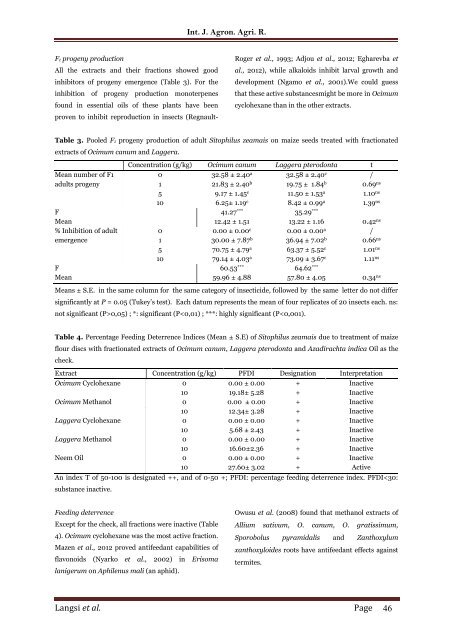Evaluation of the insecticidal properties of fractionated extracts of Ocimum canum and Laggera pterodonta on stored maize against the infestation of Sitophilus zeamais (Coleoptera: Curculionidae)
Abstract The weevil, Sitophilus zeamais (Motschulsky), is a devastating pest of stored maize, especially in the warm humid tropical regions. The objective of this study was to test the insecticidal properties of fractionated Ocimum canum and Laggera pterodonta extracts used as natural alternatives to synthetic insecticides in the management of maize S. zeamais weevils. Fractionated extracts were obtained by maceration of the leaves of O. canum and Laggera pterodonta. Cyclohexane, acetone and methanol were used as extraction solvents and the tests were carried out at 1, 5 and 10 g/kg on adult S. zeamais, for mortality, progeny production inhibition, feeding deterrence and repellence with a control that received no extract treatment. Adult mortality was recorded within 1, 7 and 14 days post-exposure. All the fractions showed insecticidal activity that increased with dosage and period of post-treatment. At 10 g/kg the Laggera methanol fraction caused a mortality of 20 % within 14 days of exposure, and a progeny production inhibition rate of over 84 %. Laggera Cyclohexane fraction (5 g/kg) that showed repellence index of 75.44 % greater than neem oil (Azadirachta indica) that served as the positive control referenced plant.
Abstract
The weevil, Sitophilus zeamais (Motschulsky), is a devastating pest of stored maize, especially in the warm humid tropical regions. The objective of this study was to test the insecticidal properties of fractionated Ocimum canum and Laggera pterodonta extracts used as natural alternatives to synthetic insecticides in the management of maize S. zeamais weevils. Fractionated extracts were obtained by maceration of the leaves of O. canum and Laggera pterodonta. Cyclohexane, acetone and methanol were used as extraction solvents and the tests were carried out at 1, 5 and 10 g/kg on adult S. zeamais, for mortality, progeny production inhibition, feeding deterrence and repellence with a control that received no extract treatment. Adult mortality was recorded within 1, 7 and 14 days post-exposure. All the fractions showed insecticidal activity that increased with dosage and period of post-treatment. At 10 g/kg the Laggera methanol fraction caused a mortality of 20 % within 14 days of exposure, and a progeny production inhibition rate of over 84 %. Laggera Cyclohexane fraction (5 g/kg) that showed repellence index of 75.44 % greater than neem oil (Azadirachta indica) that served as the positive control referenced plant.
You also want an ePaper? Increase the reach of your titles
YUMPU automatically turns print PDFs into web optimized ePapers that Google loves.
Int. J. Agr<strong>on</strong>. Agri. R.<br />
F1 progeny producti<strong>on</strong><br />
All <str<strong>on</strong>g>the</str<strong>on</strong>g> <str<strong>on</strong>g>extracts</str<strong>on</strong>g> <str<strong>on</strong>g>and</str<strong>on</strong>g> <str<strong>on</strong>g>the</str<strong>on</strong>g>ir fracti<strong>on</strong>s showed good<br />
inhibitors <str<strong>on</strong>g>of</str<strong>on</strong>g> progeny emergence (Table 3). For <str<strong>on</strong>g>the</str<strong>on</strong>g><br />
inhibiti<strong>on</strong> <str<strong>on</strong>g>of</str<strong>on</strong>g> progeny producti<strong>on</strong> m<strong>on</strong>oterpenes<br />
found in essential oils <str<strong>on</strong>g>of</str<strong>on</strong>g> <str<strong>on</strong>g>the</str<strong>on</strong>g>se plants have been<br />
proven to inhibit reproducti<strong>on</strong> in insects (Regnault-<br />
Roger et al., 1993; Adjou et al., 2012; Egharevba et<br />
al., 2012), while alkaloids inhibit larval growth <str<strong>on</strong>g>and</str<strong>on</strong>g><br />
development (Ngamo et al., 2001).We could guess<br />
that <str<strong>on</strong>g>the</str<strong>on</strong>g>se active substancesmight be more in <str<strong>on</strong>g>Ocimum</str<strong>on</strong>g><br />
cyclohexane than in <str<strong>on</strong>g>the</str<strong>on</strong>g> o<str<strong>on</strong>g>the</str<strong>on</strong>g>r <str<strong>on</strong>g>extracts</str<strong>on</strong>g>.<br />
Table 3. Pooled F1 progeny producti<strong>on</strong> <str<strong>on</strong>g>of</str<strong>on</strong>g> adult <strong>Sitophilus</strong> <strong>zeamais</strong> <strong>on</strong> <strong>maize</strong> seeds treated with <str<strong>on</strong>g>fracti<strong>on</strong>ated</str<strong>on</strong>g><br />
<str<strong>on</strong>g>extracts</str<strong>on</strong>g> <str<strong>on</strong>g>of</str<strong>on</strong>g> <str<strong>on</strong>g>Ocimum</str<strong>on</strong>g> <str<strong>on</strong>g>canum</str<strong>on</strong>g> <str<strong>on</strong>g>and</str<strong>on</strong>g> <str<strong>on</strong>g>Laggera</str<strong>on</strong>g>.<br />
C<strong>on</strong>centrati<strong>on</strong> (g/kg) <str<strong>on</strong>g>Ocimum</str<strong>on</strong>g> <str<strong>on</strong>g>canum</str<strong>on</strong>g> <str<strong>on</strong>g>Laggera</str<strong>on</strong>g> <str<strong>on</strong>g>pterod<strong>on</strong>ta</str<strong>on</strong>g> t<br />
Mean number <str<strong>on</strong>g>of</str<strong>on</strong>g> F1<br />
0 32.58 ± 2.40 a 32.58 ± 2.40 c /<br />
adults progeny<br />
1 21.83 ± 2.40 b 19.75 ± 1.84 b 0.69 ns<br />
5 9.17 ± 1.45 c 11.50 ± 1.53 a 1.10 ns<br />
10 6.25± 1.19 c 8.42 ± 0.99 a 1.39 ns<br />
F 41.27 *** 35.29 ***<br />
Mean 12.42 ± 1.51 13.22 ± 1.16 0.42 ns<br />
% Inhibiti<strong>on</strong> <str<strong>on</strong>g>of</str<strong>on</strong>g> adult<br />
emergence<br />
0 0.00 ± 0.00 c 0.00 ± 0.00 a /<br />
1 30.00 ± 7.87 b 36.94 ± 7.02 b 0.66 ns<br />
5 70.75 ± 4.79 a 63.37 ± 5.52 c 1.01 ns<br />
10 79.14 ± 4.03 a 73.09 ± 3.67 c 1.11 ns<br />
F 60.53 *** 64.62 ***<br />
Mean 59.96 ± 4.88 57.80 ± 4.05 0.34 ns<br />
Means ± S.E. in <str<strong>on</strong>g>the</str<strong>on</strong>g> same column for <str<strong>on</strong>g>the</str<strong>on</strong>g> same category <str<strong>on</strong>g>of</str<strong>on</strong>g> insecticide, followed by <str<strong>on</strong>g>the</str<strong>on</strong>g> same letter do not differ<br />
significantly at P = 0.05 (Tukey’s test). Each datum represents <str<strong>on</strong>g>the</str<strong>on</strong>g> mean <str<strong>on</strong>g>of</str<strong>on</strong>g> four replicates <str<strong>on</strong>g>of</str<strong>on</strong>g> 20 insects each. ns:<br />
not significant (P>0,05) ; *: significant (P





![Review on: impact of seed rates and method of sowing on yield and yield related traits of Teff [Eragrostis teff (Zucc.) Trotter] | IJAAR @yumpu](https://documents.yumpu.com/000/066/025/853/c0a2f1eefa2ed71422e741fbc2b37a5fd6200cb1/6b7767675149533469736965546e4c6a4e57325054773d3d/4f6e6531383245617a537a49397878747846574858513d3d.jpg?AWSAccessKeyId=AKIAICNEWSPSEKTJ5M3Q&Expires=1715209200&Signature=8dSyAqKT1sduLByP3VBR5KpjfiU%3D)












